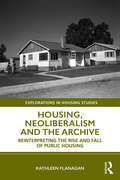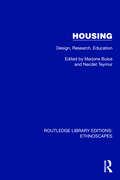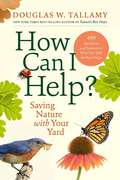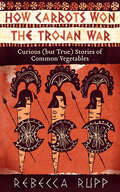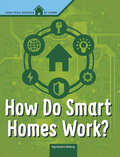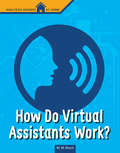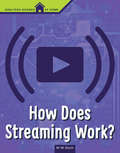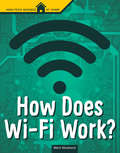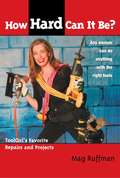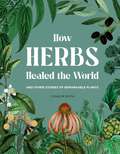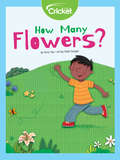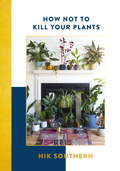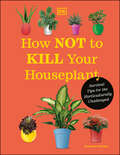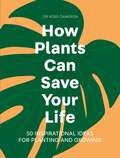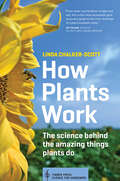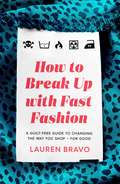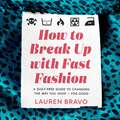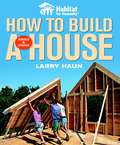- Table View
- List View
Housing, Neoliberalism and the Archive: Reinterpreting the Rise and Fall of Public Housing (Explorations in Housing Studies)
by Kathleen FlanaganFrom the mid-1940s, state housing authorities in Australia built large housing estates to enable home ownership by working-class families, but the public housing system they created is now regarded as broken. Contemporary problems with the sustainability, effectiveness and reputation of the Australian public housing system are usually attributed to the influence of neoliberalism. Housing, Neoliberalism and the Archive offers a challenge to this established ‘rise and fall’ narrative of post-war housing policy. Kathleen Flanagan uses Foucauldian ‘archaeology’ to analyse archival evidence from the Australian state of Tasmania. Through this, she reveals that the difference between past and present knowledge about the value, role and purpose of public housing results from a significant discontinuity in the way we think and act in relation to housing policy. Flanagan describes the complex system of ideas and events that underpinned policy change in Tasmania while telling a story about state housing policy, neoliberalism and history that has resonance for many other places and times. In the process, she shows that the story of public housing is more complicated than the taken-for-granted neoliberal narrative and that this finding has real significance for the dilemmas in public housing policy that face us in the here and now.
Housing: Design, Research, Education (Routledge Library Editions: Ethnoscapes)
by Necdet Teymur Marjorie BulosOriginally published in 1993, as part of the Ethnoscapes: Current Challenges in the Environmental Social Sciences series, reissued now with a new series introduction, Housing: Design, Research and Education, demonstrated some of the diversity and richness of the research being undertaken in housing at time, which took as its starting point peoples’ notion of home and the way in which a sense of home is captured distilled and expressed through various facets of design, and conversely the urgent need for architects and planners to take seriously the everyday scale and scope of peoples’ home experience. The breadth of subject background and cultural location from which these chapters are drawn provides stimulating reading at the same time as presenting a challenging choice of perspectives.
How Can I Help?: Saving Nature with Your Yard
by Douglas W. TallamyFrom a New York Times bestselling author, a wildlife ecology expert and environmental advocate provides readers with the next step in their ecological journey. In How Can I Help?, Tallamy tackles the questions commonly asked at his popular lectures and shares compelling and actionable answers that will help gardeners and homeowners take the next step in their ecological journey. Topics range from ecology, evolution, biodiversity and conservation to restoration, native plants, invasive species, pest control, and supporting wildlife at home. Tallamy keenly understands that most people want to take part in conservation efforts but often feel powerless to do so as individuals. But one person can make a difference, and How Can I Help? details how. Whether by reducing your lawn, planting a handful of native species, or allowing leaves to sit untouched, you will be inspired and empowered to join millions of other like-minded people to become the future of backyard conservation.
How Carrots Won the Trojan War: Curious (but True) Stories of Common Vegetables
by Rebecca RuppDiscover why Roman gladiators were massaged with onion juice before battle, how celery contributed to Casanova’s conquests, how peas almost poisoned General Washington, and why some seventeenth-century turnips were considered degenerate. Rebecca Rupp tells the strange and fascinating history of 23 of the world’s most popular vegetables. Gardeners, foodies, history buffs, and anyone who wants to know the secret stories concealed in a salad are sure to enjoy this delightful and informative collection.
How Do Smart Homes Work? (High Tech Science at Home)
by Agnieszka BiskupImagine you arrive at school and realize you forgot to feed the dog. No problem. Pull out your phone and command the dog dish to dispense a serving of food. That's all there is to it - if you live a smart home. What once sounded like science fiction is now a reality for some families. People use smart phones and other devices to lock doors, turn on lights, close window shades, and check to see how much milk they have in the fridge. Find out how this technology works and what the future holds for smart homes.
How Do Virtual Assistants Work? (High Tech Science at Home)
by M. M. EbochA virtual assistant by any name - Alexa, Siri, whoever - can be a sweet addition to your home. You might use one for simple jobs like playing music or streaming podcasts. And you might use one to communicate with friends and remind you about homework coming due while helping you make your breakfast. Find out how digital assistants work and what the future might hold for this part of a high-tech home.
How Does Streaming Work? (High Tech Science at Home)
by M. M. EbochWhether you're watching a movie, bingeing on a classic TV show, or listening to your favorite song, you're probably streaming it. Videotapes, DVDs, and CDs are mostly just memories now. Streaming puts a world of options at your fingertips when you’re at home and, with a smartphone or tablet, when you're on the go. Find out how streaming was invented, how it works, and what the future might hold for this part of a high-tech life.
How Does Wi-Fi Work? (High Tech Science at Home)
by Mark WeaklandYou probably use Wi-Fi all the time to connect to the internet through your laptop, tablet, or phone. It's easy. Wi-Fi hotspots surround you as you go through your day - from school to a pizza place or coffee shop and then back home. Not so long ago, the internet wasn't as accessible. Find out how Wi-Fi works, how it became commonplace, and what it might do for you in the future.
How Happy Is Your Home?
by Sophie KellerChange your home...for the happier.With these 50 tips, you'll learn how to apply the principles of feng shui to make your home a healthier, happier place to live. Discover:- How to bring more love in through your front door.- Simple office solutions that will increase your income.- Where to place your bed for better sex and better sleep.Take charge of your happiness, one tip at a time.
How Hard Can It Be?
by Steven Smith Mag Ruffman"You can pay big money for a self-esteem seminar, or you can buy yourself a cordless drill. I recommend the drill." Only the ToolGirl can make unplugging a blocked drain entertaining! Mag Ruffman, with characteristic flair and attitude, encourages readers to confront their terror of household maintenance and accomplish those nagging home repairs and improvements. Whether you¿re a rank beginner, first-time homeowner, or an apartment-dweller who's fed up with a lazy super, you¿ll find the know-how in this book to accomplish your goals.
How Hard Can It Be?: Toolgirl's Favorite Repairs And Projects
by Steve Smith Mag Ruffman"You can pay big money for a self-esteem seminar, or you can buy yourself a cordless drill. I recommend the drill." Only the ToolGirl can make unplugging a blocked drain entertaining! Mag Ruffman, with characteristic flair and attitude, encourages readers to confront their terror of household maintenance and accomplish those nagging home repairs and improvements. Whether you¿re a rank beginner, first-time homeowner, or an apartment-dweller who's fed up with a lazy super, you¿ll find the know-how in this book to accomplish your goals.
How Herbs Healed the World: And Other Stories of Remarkable Plants
by Connor Smith'The writing shines when recounting the stories behind these herbs, offering a blend of history and botanical fascination' - RHS, The GardenHerbs are wonderful things. Without them so much would not be possible. With the advance of science over the last two hundred years these once mystical plants have changed and saved countless lives, vastly improving our standard of living while providing us all with a much richer, healthier diet. Today, we take for granted a world full oflife-saving drugs, luxury cosmetics and exotic foods.This fascinating book will tell this story: revealing how poisons once used by the ancient Romans such as Deadly Nightshade are now being used in modern medicine or how the herbs used by indigenous people around the world have provided remedies for countless illnesses. It will explore the myths and legends behind herbs such as the infamous Mandrake and how herbs such as Yarrow are still being used to treat wounds today, just as they were thousands of years ago; and it will show how exotic herbs from across the globe have enriched our livesand delve into the origins of the culinary herbs that everyone knows and loves.Seventy-five herbs have been carefully chosen to tell the story of how they have each changed our world, looking back at their origins and what was once believed, while comparing this with the modern day uses and the scientific value of these plants enabling the reader to understand and appreciate their importance.Each double page spread will provide both historic and modern illustrations of each herb alongside captivating accounts of their historical and modern day uses including supplementary botanical and horticultural information for each.
How Herbs Healed the World: And Other Stories of Remarkable Plants
by Connor Smith'The writing shines when recounting the stories behind these herbs, offering a blend of history and botanical fascination' - RHS, The GardenHerbs are wonderful things. Without them so much would not be possible. With the advance of science over the last two hundred years these once mystical plants have changed and saved countless lives, vastly improving our standard of living while providing us all with a much richer, healthier diet. Today, we take for granted a world full oflife-saving drugs, luxury cosmetics and exotic foods.This fascinating book will tell this story: revealing how poisons once used by the ancient Romans such as Deadly Nightshade are now being used in modern medicine or how the herbs used by indigenous people around the world have provided remedies for countless illnesses. It will explore the myths and legends behind herbs such as the infamous Mandrake and how herbs such as Yarrow are still being used to treat wounds today, just as they were thousands of years ago; and it will show how exotic herbs from across the globe have enriched our livesand delve into the origins of the culinary herbs that everyone knows and loves.Seventy-five herbs have been carefully chosen to tell the story of how they have each changed our world, looking back at their origins and what was once believed, while comparing this with the modern day uses and the scientific value of these plants enabling the reader to understand and appreciate their importance.Each double page spread will provide both historic and modern illustrations of each herb alongside captivating accounts of their historical and modern day uses including supplementary botanical and horticultural information for each.
How Many Flowers
by Amy TaoDo you know how new fruit is made? Learn about the different parts of a fruit plant’s flower—the stigma, pistil, and stamen—and how they use pollen to make seeds in a process called pollination! The seeds grow into new flowers, which turn into fruit after they’re pollinated!
How Not To Kill Your Plants
by Nik SouthernHands up if you've killed a plant? Yep, me too. It's no secret that we've all become plant obsessed, but do we really understand how to look after them? I am not a Professor of Botany, but having run my florist and plant shop, Grace & Thorn, since 2011 I've learnt a few things along the way. HOW NOT TO KILL YOUR PLANTS is about taking the hocus-pocus out of plants and flowers and enabling you to understand a plant's needs in order to know where to place and how to style them, but most importantly how to keep them alive.I get asked every type of question you can imagine and I have written this book to answer them. Watering can down, it's time to go back to the roots.Keep it green.Nik x(AKA The Agony Plant)
How Not To Kill Your Plants: Know, Grow And Style
by Nik SouthernHands up if you've killed a plant? Yep, me too. It's no secret that we've all become plant obsessed, but do we really understand how to look after them? I am not a Professor of Botany, but having run my florist and plant shop, Grace & Thorn, since 2011 I've learnt a few things along the way. HOW NOT TO KILL YOUR PLANTS is about taking the hocus-pocus out of plants and flowers and enabling you to understand a plant's needs in order to know where to place and how to style them, but most importantly how to keep them alive.I get asked every type of question you can imagine and I have written this book to answer them. Watering can down, it's time to go back to the roots.Keep it green.Nik x(AKA The Agony Plant)
How Not to Kill Your Houseplant New Edition: Survival Tips for the Horticulturally Challenged
by Veronica PeerlessHow to keep alive 119 gorgeous indoor plants, then help them bloom and thrive.You&’ve welcomed a plant into the home: Now what? Your first job is to keep it alive, then after that help it bloom and thrive. Learn all the tips and tricks you need to become a proud plant parent—of more than 100 different plants (if you&’re up for it)!Yellowed leaves, drooping leaves, dried leaves, even though you've watered it: What&’s going on? How Not to Kill Your Houseplant will explain—and fix—your houseplant woes. Learn to spot the danger signs and take the proper action to rescue your sick plant. Follow quick tips to understand what your plant does and doesn't like: how much light, water, food, heat, and humidity.Discover the perfect plant for your unique space and needs. Bathrooms, cold rooms, at a desk, on a windowsill, or in a gloomy corner or hot suntrap—there are plants for every location to create your own indoor oasis.This is your guide to every stage of plant parenting for beginners, from identifying exactly what's in the pot to keeping it in check when it grows too well!
How Plants Can Save Your Life: 50 Inspirational Ideas for Planting and Growing
by Ross CameronGrowing plants and (if we are lucky enough) creating gardens is deeply rewarding, but has also been proven to be vital for our health.Gardening helps improve our mood, relax us, take us away from our everyday problems, and promote positive emotions. It reduces anxiety and stress, delays in the onset of dementia, promotes joy, as well as improving physical health and even self-esteem.This new book explores the ways we can introduce plants into our lives and thus embrace some of the benefits the natural world provides for our well-being. Divided into 50 sections, each one highlights a plant-based activity, how this is good for your health and provides links to the underlying concept that supports health and well-being.Written by a leading scientific authority on environmental horticulture, this unique book will offer readers a wealth of ideas on planting and growing as well as explaining the latest science research behind those ideas.
How Plants Can Save Your Life: 50 Inspirational Ideas for Planting and Growing
by Ross CameronGrowing plants and (if we are lucky enough) creating gardens is deeply rewarding, but has also been proven to be vital for our health.Gardening helps improve our mood, relax us, take us away from our everyday problems, and promote positive emotions. It reduces anxiety and stress, delays in the onset of dementia, promotes joy, as well as improving physical health and even self-esteem.This new book explores the ways we can introduce plants into our lives and thus embrace some of the benefits the natural world provides for our well-being. Divided into 50 sections, each one highlights a plant-based activity, how this is good for your health and provides links to the underlying concept that supports health and well-being.Written by a leading scientific authority on environmental horticulture, this unique book will offer readers a wealth of ideas on planting and growing as well as explaining the latest science research behind those ideas.
How Plants Work: The Science Behind the Amazing Things Plants Do (Science For Gardeners Ser.)
by Linda Chalker-ScottThe more you know, the better you grow! Plants are capable of interesting and unexpected things. Why do container plants wilt when they’ve been regularly watered? Why did the hydrangea that thrived last year never bloom this year? Why do slugs wipe out the vegetable garden instead of eating the weeds? Plant physiology—the study of how living things function—can solve these and most other problems gardeners regularly encounter.In How Plants Work, horticulture expert and contributor to the popular blog The Garden Professors, Linda Chalker-Scott brings the stranger-than-fiction science of the plant world to vivid life. She uncovers the mysteries of how and why plants do the things they do, and arms the home gardener with fascinating knowledge that will change the way they garden.
How To Break Up With Fast Fashion: A guilt-free guide to changing the way you shop – for good
by Lauren Bravo'A funny, achievable guide' Observer'Lauren Bravo is one of my favourite writers' Dolly Alderton'Bravo will inspire you to repair, recycle and give old items a new lease of life' StylistYou probably know the statistics: global clothing production has roughly doubled in just 15 years, and every year an estimated 300,000 tonnes of used clothing ends up in UK landfill.Fast fashion is the ultimate toxic relationship. It's bad news for the planet, our brains and our bank balances. We can't go on like this; our shopping habits need an overhaul.Journalist Lauren Bravo loves clothes more than anything, but she's called time on her affair with fast fashion in search of a slower, saner way of dressing. In this book, she'll help you do the same.How To Break Up With Fast Fashion will help you to change your mindset, fall back in love with your wardrobe and embrace more sustainable ways of shopping - from the clothes swap to the charity shop. Full of refreshing honesty and realistic advice, Lauren will inspire you to repair, recycle and give your unloved items a new lease of life without sacrificing your style.Because fashion belongs to everyone, but no outfit should cost us the earth.
How To Break Up With Fast Fashion: A guilt-free guide to changing the way you shop – for good
by Lauren Bravo'A funny, achievable guide' Observer'Lauren Bravo is one of my favourite writers' Dolly Alderton'Bravo will inspire you to repair, recycle and give old items a new lease of life' StylistYou probably know the statistics: global clothing production has roughly doubled in just 15 years, and every year an estimated 300,000 tonnes of used clothing ends up in UK landfill.Fast fashion is the ultimate toxic relationship. It's bad news for the planet, our brains and our bank balances. We can't go on like this; our shopping habits need an overhaul.Journalist Lauren Bravo loves clothes more than anything, but she's called time on her affair with fast fashion in search of a slower, saner way of dressing. In this book, she'll help you do the same.How To Break Up With Fast Fashion will help you to change your mindset, fall back in love with your wardrobe and embrace more sustainable ways of shopping - from the clothes swap to the charity shop. Full of refreshing honesty and realistic advice, Lauren will inspire you to repair, recycle and give your unloved items a new lease of life without sacrificing your style.Because fashion belongs to everyone, but no outfit should cost us the earth.
How To Break Up With Fast Fashion: A guilt-free guide to changing the way you shop – for good
by Lauren BravoYou probably know the statistics: global clothing production has roughly doubled in just 15 years, and every year an estimated 300,000 tonnes of used clothing ends up in UK landfill. Fast fashion is the ultimate toxic relationship. It's bad news for the planet, our brains and our bank balances. We can't go on like this; our shopping habits need an overhaul.Journalist Lauren Bravo loves clothes more than anything, but she's called time on her affair with fast fashion in search of a slower, saner way of dressing. In this book, she'll help you do the same. How To Break Up With Fast Fashion will help you to change your mindset, fall back in love with your wardrobe and embrace more sustainable ways of shopping - from the clothes swap to the charity shop. Full of refreshing honesty and realistic advice, Lauren will inspire you to repair, recycle and give your unloved items a new lease of life without sacrificing your style. Because fashion belongs to everyone, but no outfit should cost us the earth. (P)2020 Headline Publishing Group Ltd
How To Build A House (Habitat for Humanity)
by Larry Haun Vincent Laurence Tim Snyder Angela C. JohnsonSince its founding in 1976, the non-profit Habitat for Humanity International has built more than 255,000 houses for more than one million people and families in need world wide. First published in 2002, Habitat for Humanity How to Build a House has helped thousands more build simple, energy-efficient homes of their own by helping guide them from foundation to roof, through all interior finishes and fixtures. Written by long-time carpenter and Habitat volunteer, Larry Haun, this extensive revision features up-to-date information on residential codes, construction methods, and materials -- as well as an updated design inside and out. Haun also provides new sections on tools, siding, ventilation, and landscaping. With clear information on everything from obtaining a site and permit to finishing touches like installing door locks and cabinets, this is the best single-volume resource for the beginning homebuilder.
How To Clean Everything: The Authoritative Guide to Cleaning, Conditioning and Stain Removal for Every Type of Material and Surface (3rd Edition)
by Alma Chesnut MooreFrom the book: HOW TO CLEAN EVERYTHING is a comprehensive guide to cleaning any material, removing any stain and caring for any object. This manual, now available from JOB SQUAD, will become so indispensable, you will wonder how you ever managed to clean a home without it! Among the hundreds of tips offered are: Remove chewing gum (if water does not spot the material) by rubbing the gummy portion with a piece of ice. Then you can scrape or rub the gum out of the fabric. Clean a diamond ring by boiling mild soapsuds with a few drips of ammonia added, immersing the ring, dipping it into a small bowl of alcohol, and letting it dry on tissue paper. Remove fresh coffee and tea stains (if it's safe for the fabric) by stretching the stained portion of cloth over an open bowl and securing it with a rubber band. From a height of 1 to 3 feet, pour boiling water over the cloth. From awnings to Venetian blinds, cashmere to silk, coral to vinyl, HOW TO CLEAN EVERYTHING provides the best methods for ensuring a long and beautiful life for your belongings.
